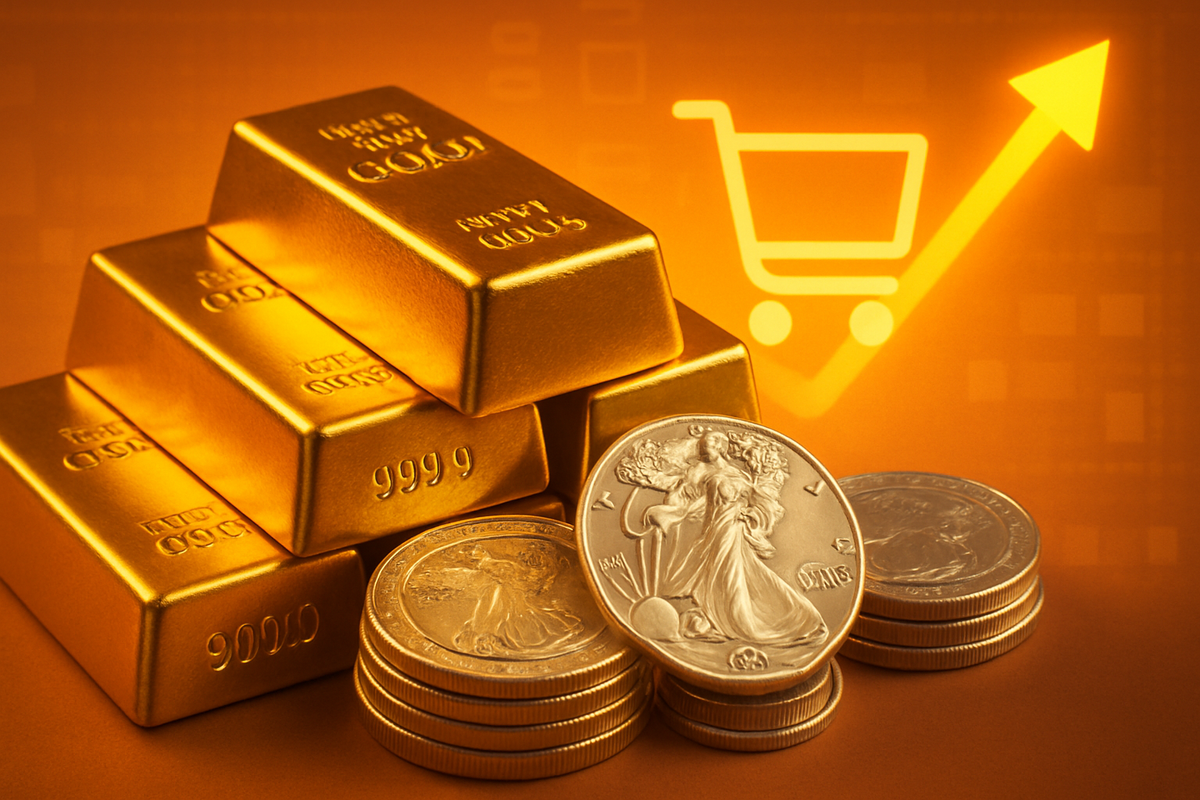Financial News
Costco's Golden Touch: How Precious Metals Sales Are Fueling E-commerce Amidst a Historic Rally

In an unexpected twist of retail fate, warehouse giant Costco Wholesale Corporation (NASDAQ: COST) has found itself at the forefront of a booming precious metals market. As gold prices shatter historical records, soaring past an unprecedented $4,000 per ounce, and silver follows suit with a meteoric rise, physical gold bars and silver coins have become unlikely top sellers for the membership-only retailer. This unique trend is not only significantly bolstering Costco's e-commerce business but also offering a fascinating glimpse into shifting consumer and investor sentiment in an era of economic uncertainty and geopolitical flux.
The phenomenon underscores a broader 'flight to safety' as everyday consumers and seasoned investors alike seek tangible assets to hedge against inflation and market volatility. Costco, leveraging its reputation for value and trustworthiness, has inadvertently democratized precious metals investment, making it accessible to a mainstream audience. The rapid sell-outs and robust online sales figures highlight a powerful confluence of a historic commodities rally and a retailer's savvy adaptation to evolving consumer needs, marking a significant, albeit thin-margined, win for the company's digital footprint.
The Unprecedented Rush: Gold and Silver Ignite Costco's Digital Aisles
Costco's journey into the precious metals market began subtly in September 2023, with the online introduction of 1-ounce 24-karat gold bars. Initially priced around $2,000, these bars quickly became an internet sensation, selling out within hours of each restock. Recognizing the immense demand, Costco expanded its offerings in January 2024 to include 25-count tubes of one-ounce silver coins, and later, platinum bars, with gold consistently remaining the top seller.
The timing couldn't have been more fortuitous. Costco's entry coincided with the nascent stages of a precious metals bull run that has since accelerated dramatically. Gold, which rose 13% in 2023 and 27% in 2024, has seen an astonishing 50% year-to-date surge in 2025, culminating in its historic breach of the $4,000 mark on October 7-8, 2025. Silver, often gold's more volatile counterpart, has also witnessed a "meteoric rise," crossing $30 per ounce in 2024 and approaching $47-$48 per ounce by early October 2025, boasting over 55% year-to-date gains. This rally is fueled by persistent inflation, geopolitical instability, and expectations of continued interest rate cuts by the Federal Reserve.
The impact on Costco's e-commerce business has been profound. In its fiscal Q2 2024, e-commerce sales surged over 18%, significantly outpacing overall company growth, "led by sales of gold, and very recently silver." This trend continued, with gold and silver bullion sales driving an 18.9% growth in e-commerce comparable sales for Q4 2024 and a 13% surge in Q1 2025 e-commerce sales. Wells Fargo analysts estimated monthly bullion revenue for Costco between $100 million and $200 million by April 2024, with more recent estimates in September 2025 suggesting sales exceeding $200 million per month. The overwhelming demand has led Costco to implement strict purchase limits, typically one or two units per membership per transaction, often selling out within minutes. This aggressive pricing, combined with Costco's trusted brand, has made it a go-to for both seasoned and first-time precious metals investors.
Winners and Watchers: The Ripple Effect on the Market
Costco's unexpected success in the bullion market has created clear "wins" for the warehouse retailer, while presenting a more nuanced dynamic for traditional precious metals dealers and the broader market.
For Costco (NASDAQ: COST), the benefits are multi-faceted. Financially, while direct profit margins on precious metals are razor-thin (estimated at around 2% above spot price), the sheer volume of sales translates into significant revenue contribution, substantially boosting its e-commerce growth figures and even adding approximately 1% to its overall same-store sales. Beyond direct revenue, these high-demand items act as powerful magnets for membership acquisition and retention, drawing new customers to sign up for Costco memberships to gain access to the exclusive offerings. This, in turn, contributes to the company's consistent growth in membership fee income. Furthermore, the "treasure hunt" allure of rapidly selling out gold and silver bars reinforces Costco's brand perception as a diverse, value-driven retailer offering unexpected, high-value items, generating considerable media buzz and customer engagement. The increased online traffic also creates cross-selling opportunities, as members often add other items to their cart during bullion purchases.
The impact on traditional precious metals dealers is more complex. On one hand, Costco's aggressive pricing and massive scale create competitive pressure, especially for smaller dealers who cannot match its low markups. Some market share for entry-level buyers might be diverted. However, many professional bullion dealers view Costco's entry as largely complementary. It introduces a new, mainstream audience to physical gold and silver ownership, often educating first-time buyers about precious metals as a hedge against inflation and uncertainty. These newly initiated investors may eventually seek greater variety, larger volumes, or specific services (like secure storage or diverse product types) that traditional dealers offer but Costco does not. Crucially, Costco does not offer buyback options, meaning buyers must eventually engage with traditional dealers for selling their bullion, ultimately benefiting the secondary market. Other large retailers might be inspired to follow suit, intensifying competition but also expanding the overall market for physical precious metals.
A Wider Lens: Economic Anxiety and the Return of Hard Assets
The sustained rally in gold and silver, now pushing prices to historic highs in October 2025, is far more than a simple market fluctuation; it is a profound indicator of deep-seated anxieties among consumers and investors. This "flight to safety" reflects a pervasive lack of confidence in the stability of traditional financial systems, persistent inflationary pressures, and escalating geopolitical risks. The widespread embrace of tangible assets like gold and silver, even through unconventional channels like Costco, signals a collective reappraisal of trust, sovereignty, and what truly constitutes a "safe" store of value.
The primary drivers of this sentiment include lingering concerns about inflation eroding purchasing power, despite central bank efforts. Gold and silver are historically viewed as hedges against such erosion. Geopolitical tensions, from ongoing conflicts in Eastern Europe and the Middle East to political instability in various nations and concerns over a potential prolonged U.S. government shutdown, further fuel investor anxiety, prompting a rush into safe-haven assets. Moreover, the expectation of continued interest rate cuts by the U.S. Federal Reserve reduces the opportunity cost of holding non-yielding assets, making them more attractive compared to fixed-income alternatives that offer unattractive real returns in an inflationary environment. Central banks globally are also accelerating their gold purchases, diversifying away from the U.S. dollar and hedging against potential sanctions.
Costco's success in selling precious metals fits into a broader industry trend of the democratization of investment. By making physical gold and silver accessible to its millions of members, Costco has mainstreamed an asset class traditionally associated with specialized dealers or institutional investors. This aligns with a growing retail investor interest in tangible assets, as evidenced by surveys indicating that a strong majority of retail traders expect gold prices to remain elevated. Historically, such periods of consumer-driven precious metal purchases often coincide with economic turbulence. The current surge, with gold's 50-53% year-to-date gain, is its strongest rally since the 1970s oil crisis, a period also marked by high inflation and economic uncertainty. Similarly, gold performed strongly during the 2008 financial crisis and the 2020 pandemic. Silver's tendency to dramatically outpace gold in later stages of a bull market, as seen historically, also appears to be repeating in the current rally.
The Road Ahead: Sustaining the Spark
Looking ahead, the outlook for precious metals, particularly gold and silver, remains largely bullish for both the short and long term, extending into 2026 and beyond. As of October 2025, gold's surge past $4,000 per ounce sets a new benchmark, with many analysts projecting further appreciation. J.P. Morgan Research anticipates gold averaging $3,675/oz by Q4 2025 and potentially reaching $4,000/oz by mid-2026, while Goldman Sachs forecasts a climb to $4,900 by 2026. Long-term projections from various sources suggest gold could even reach $5,000-$8,900 by 2030. Silver is also expected to continue its ascent, with forecasts ranging from $40 per ounce in 2025 to potentially exceeding $70-$90 by 2030, driven by both safe-haven demand and robust industrial use in green technologies.
For Costco (NASDAQ: COST), sustaining its precious metals momentum will require strategic adaptation. Given the rapid sell-outs, enhancing its supply chain and diversifying sourcing relationships with refiners will be crucial to maintain consistent, albeit limited, inventory. While direct profitability is minimal, Costco's primary goal with bullion sales appears to be driving membership and e-commerce growth. Therefore, carefully managing its low-premium structure to balance member value with logistical costs will be key. Further refining its e-commerce experience to handle high demand, provide real-time inventory updates, and offer effective restock notifications could enhance customer satisfaction. While unlikely to offer direct storage, providing members with trustworthy educational content about precious metals investment and secure storage options could further empower customers and reinforce its reputable image. Leveraging the exclusivity of these offerings will continue to be vital for membership acquisition and retention.
Market opportunities for Costco include continued membership growth, an enhanced brand perception, and revenue diversification. Challenges, however, include managing thin profit margins, navigating supply chain volatility, and mitigating potential risks from price fluctuations. For the broader precious metals market, opportunities lie in a likely sustained bull market fueled by persistent inflation, central bank demand, geopolitical instability, and growing industrial demand for silver. Challenges include potential reversals in monetary policy, a strengthening US dollar, or a significant resolution of global conflicts that could diminish safe-haven demand.
A Golden Legacy: Redefining Retail and Investment
The current precious metals rally, culminating in gold's historic breach of $4,000 per ounce, represents a pivotal moment in global finance. It unequivocally underscores widespread concerns about economic stability, persistent inflation, and geopolitical risks, pushing investors and consumers alike towards the tangible security of gold and silver. Costco's unexpected, yet highly successful, foray into selling these precious metals has not only significantly boosted its e-commerce revenue and membership growth but has also played a unique role in democratizing access to physical bullion for the mainstream consumer.
This trend solidifies gold's enduring status as a premier safe-haven asset and highlights a strategic diversification away from traditional fiat currencies by central banks worldwide. Costco's ability to seamlessly integrate high-value, non-traditional goods into its "treasure hunt" model has redefined retail boundaries, proving that trusted brands can effectively tap into evolving consumer investment behaviors. The lasting impact of this phenomenon will likely be a heightened awareness and acceptance of physical precious metals as a crucial component of diverse investment portfolios, serving as an insurance policy against various economic and geopolitical uncertainties.
Investors in the coming months should closely monitor several key indicators: the Federal Reserve's monetary policy decisions, global inflation data, evolving geopolitical developments, and the performance of the US dollar. Furthermore, tracking central bank gold purchasing trends, ETF flows, and industrial demand for silver will provide crucial insights into the market's trajectory. While physical metal offers a stable hedge, observing the performance of precious metals mining stocks could also reveal opportunities during this sustained bull market. Costco's golden touch serves as a compelling case study of adaptability and consumer trust in a rapidly changing financial landscape, signaling a potential long-term shift in how everyday individuals approach wealth preservation.
This content is intended for informational purposes only and is not financial advice
More News
View More




Recent Quotes
View More
Quotes delayed at least 20 minutes.
By accessing this page, you agree to the Privacy Policy and Terms Of Service.



